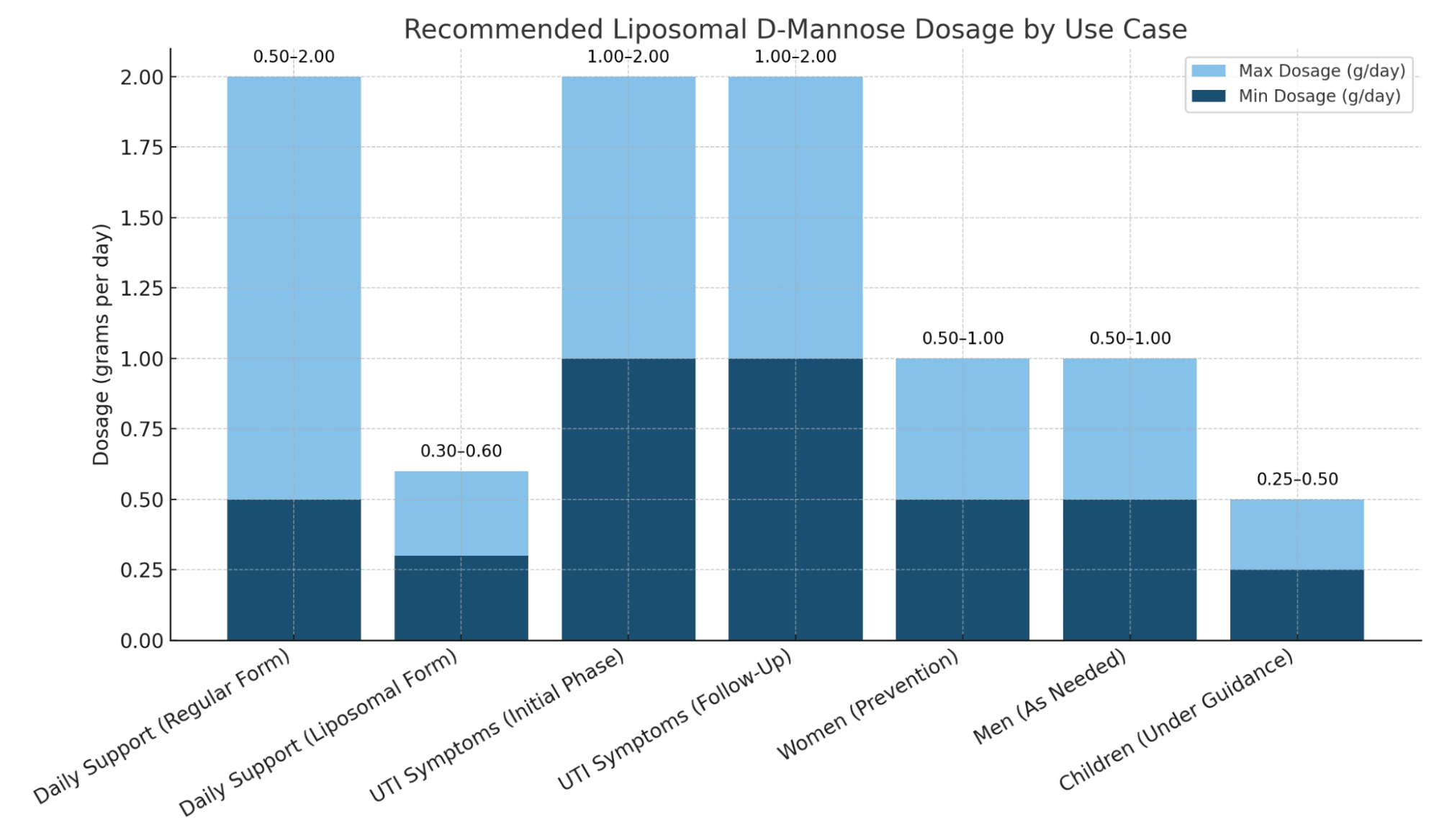
D-Mannose is a naturally occurring simple sugar closely related to glucose. It's found in small amounts in fruits like cranberries, apples, peaches, and oranges. While D-Mannose tastes sweet, it behaves very differently in the body than regular sugar.
Unlike glucose, D-Mannose is not metabolized significantly. Instead, it passes through your digestive tract and is excreted almost entirely through the urinary system. This unique property allows it to work directly on the urinary tract, making it a powerful natural option for UTI prevention and bladder support.
Here, Liposomal delivery means an advanced nutrient delivery system that involves encapsulating active ingredients (like D-Mannose) inside microscopic lipid (fat) vesicles called liposomes. These liposomes mimic the structure of cell membranes, allowing nutrients to Bypass degradation in the stomach, Improve absorption in the small intestine, Deliver directly into cells.
In essence, liposomes act like microscopic delivery drones, helping D-Mannose reach the urinary tract faster and in higher concentrations than traditional capsules or powders.
Standard D-Mannose supplements while effective may lose some potency during digestion. With liposomal delivery, you get Higher bioavailability (your body uses more of the nutrient), Faster onset of action, Longer circulation in the bloodstream.
This makes liposomal D-Mannose especially effective for those prone to recurrent UTIs or those who want more consistent, predictable urinary health support.
Miduty uses an advanced liposomal D‑Mannose delivery system, shown to be 16 times more potent than regular forms. This technology encapsulates D‑Mannose in tiny lipid‑based vesicles, enabling it to reach the bladder more efficiently, survive stomach acids, and blend directly into cell membranes unmatched by standard capsule or powder formats.
While many brands provide unspecified or minimal doses, Miduty delivers clinically validated amounts of D‑Mannose in every serving:
Acute use: High initial dose to expel bacteria
Maintenance: Effective lower dose for ongoing prevention
D‑Mannose works by inhibiting E. coli's ability to bind to bladder walls, leading to natural urinary elimination. Liposomal delivery ensures higher concentrations reach the bladder quickly more so than standard formulas.
D‑Mannose is naturally excreted through urine with minimal gut metabolism. Miduty's liposomal system ensures this benefit is enhanced without disrupting healthy gut bacteria avoiding common side effects of antibiotics and repeated antibiotic courses.
| Uses & Benefits | Description |
| Urinary Tract Infection (UTI) Prevention |
D-Mannose is most widely used as a natural alternative to antibiotics for preventing UTIs, especially those caused by Escherichia coli (E. coli), which accounts for 80–90% of UTIs. [1] It works by binding to the E. coli bacteria, preventing them from attaching to the walls of the urinary tract. Once bound, the bacteria are flushed out during urination before they can cause an infection. [2] Liposomal delivery enhances the amount of D-Mannose that reaches the bladder, providing even better prevention. |
| Post-Antibiotic Recovery | After a course of antibiotics, the urinary and gut microbiome are often disrupted, making you vulnerable to reinfection. Liposomal D-Mannose helps protect the bladder while the microbiome recovers, creating a safer, more balanced internal environment without introducing harsh chemicals or contributing to antibiotic resistance. |
| Recurrent Bladder Infections | For people who suffer from chronic or recurrent UTIs, D-Mannose can act as a maintenance supplement. Regular use reduces the frequency of infections, prevents the overuse of antibiotics, and helps break the cycle of inflammation and irritation. |
| Daily Urogenital Support |
Even for those without active infections, Liposomal D-Mannose can be used to promote bladder and kidney function, support a clean urinary environment, and maintain the mucosal health of the urinary lining. It’s especially useful for women post-menopause, diabetics, or those using catheters, who may have higher UTI risks. [3][4] |
| Prevents Bacterial Adhesion to Bladder Walls |
The primary benefit of D-Mannose is its ability to prevent harmful bacteria from sticking to the bladder lining. Most UTIs occur when E. coli invades and latches onto the urothelium (bladder wall). D-Mannose binds to the same receptors E. coli uses (called FimH), effectively blocking access and flushing bacteria out. [5] With liposomal D-Mannose, this process becomes faster and more efficient due to enhanced delivery to the urinary tract. |
For daily urinary tract support and prevention:

At the first sign of UTI symptoms:
Always follow with a maintenance dose for the next 3-5 days to ensure complete clearance.
Liposomal supplements are absorbed more effectively when taken on a relatively empty stomach. For Liposomal D-Mannose, the ideal time is first thing in the morning or between meals, when your digestive system is less active and absorption can occur more directly.
For maximum bladder exposure, taking it after urination and then drinking a full glass of water can help push the active compound to the bladder where it works most effectively.
Liposomal D-Mannose is especially helpful when taken:
You can take a preventive dose 1-2 hours before the potential trigger, and another dose afterward to support full protection.
One of the advantages of liposomal delivery is flexibility. While empty stomach usage is ideal, Liposomal D-Mannose:
Taking it with a light meal can help avoid nausea for sensitive users, although it's not necessary for everyone.
D-Mannose is a naturally occurring sugar that is excreted rapidly through the kidneys. It does not accumulate, nor does it interfere with blood sugar in healthy individuals. Liposomal D-Mannose enhances its effect, but doesn't alter its fundamental safety profile.
Most users experience no side effects when taken as directed even over extended periods. This makes it ideal for:
Although generally safe, the following groups should consult a healthcare professional before starting Liposomal D-Mannose:
Children under 12 should only use Liposomal D-Mannose under pediatric supervision.
Liposomal D-Mannose is a science-backed, natural alternative to antibiotics for urinary tract health. With superior absorption and bladder-targeted action, it:
Its gentle profile and proven effectiveness make it suitable for a wide range of users, from those battling chronic UTIs to anyone wanting preventive urinary care.
You should consider adding Miduty's Liposomal D-Mannose to your routine if you experience frequent or chronic UTIs, have urinary discomfort after antibiotics, want a natural, non-antibiotic solution, seek an advanced formula with synergistic support
With Miduty's commitment to quality, clinical dosing, and liposomal innovation, you're choosing a product that delivers real results without compromise.
D-mannose is commonly used to help prevent and manage urinary tract infections (UTIs). It works by attaching to E. coli bacteria in the urinary tract, making it easier for the body to flush them out through urine.
D-mannose may help flush out mild UTIs caused by E. coli by preventing bacteria from sticking to the bladder wall. While it can be effective for early support, severe or recurrent infections still require medical treatment.
D-mannose is generally safe for healthy kidneys when taken in recommended amounts. However, people with kidney disease or diabetes should use caution and consult a doctor before supplementation, as excessive intake may affect kidney function.
Potential disadvantages of D-mannose include digestive discomfort such as bloating or diarrhea at high doses. In rare cases, excessive use may strain the kidneys. It is not a substitute for antibiotics in serious UTIs.
When taking D-mannose, avoid excessive sugar intake and processed foods that can worsen urinary tract irritation. People with diabetes or kidney problems should avoid unsupervised use, as it may interfere with blood sugar or kidney function.
| Sr. No. | Reference |
|---|---|
| 1. | |
| 2. | |
| 3. | |
| 4. | |
| 5. | D‐mannose for preventing and treating urinary tract infections |
